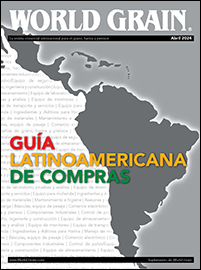LONDON, ENGLAND — World wheat flour trade in 2020-21 is forecast to increase by 4% over the previous year due to an assumed recovery in shipments to Uzbekistan and Afghanistan, the International Grains Council (IGC) said in its monthly Grain Market Report released on July 24.
At a projected 15 million tonnes (wheat equivalent), the IGC slightly reduced its 2020-21 forecast from its projection in April (15.1 million tonnes).
The IGC noted that Uzbekistan and Afghanistan are estimated to have importer “smaller-than-normal” amounts of wheat flour in 2019-20. Its most recent estimate of the recently ended year shows Afghanistan importing 1.9 million tonnes and Uzbekistan bringing in 550,000 tonnes. In the coming year, they are projected to import 2.5 million and 750,000 tonnes, respectively.
In the Middle East, large harvests are anticipated that would likely contain the import requirements for Iraq and Syria, the IGC said. Iraq, which just three years ago imported 2.627 million tonnes of flour, is forecast to import 2 million tonnes in 2020-21, 100,000 tonnes more than the previous year. Meanwhile, Syria is projected to import 450,000 tonnes, unchanged from 2019-20.
The IGC noted that Yemen is forecast to import 900,000 tonnes of flour for the second straight year as they will “likely remain at an elevated level owing to disruptions to local agriculture and processing capacity caused by conflict.”
The IGC said the overall global import picture is a bit uncertain.
“Difficult economic conditions could dampen import buying in some countries, while the coronavirus pandemic may impact needs, including where the tourism sector is negatively affected,” the IGC said.
Turkey remains top exporter
Turkey is forecast to remain the largest flour exporter, with shipments increasing 100,000 tonnes from 2019-20 to 4.9 million tonnes.
“The bulk of Turkey’s shipments will continue to the Middle East (about two-thirds of the total), where some traditional markets, such as Iraq and Syria, are likely to be well supplied from domestic harvests,” the IGC said. “Turkey is also the largest supplier to sub-Saharan Africa, where poorer economic conditions may impact import buying in some countries.”
A better harvest than last season will allow an upturn in flour exports by Kazakhstan, to 2.4 million tonnes from 2 million, including larger volumes to Uzbekistan and Afghanistan, the IGC noted.
Among the other top flour exporters, Argentina (675,000 tonnes), the EU (650,000 tonnes), and Russia (420,00 tonnes) were all projected to be unchanged from 2019-20. Ukraine is also forecast to export 420,000 tonnes, down from 500,000 the previous year.
If the global wheat flour trade projection of 15 million tonnes is realized, it would mark the first time in four years that global flour trade has increased. Since reaching its all-time peak of 17.699 million tonnes in 2016-17, global flour trade has fallen each of the last three years. Last year’s total of 14.4 million tonnes was the lowest mark since 2014-15 when 14.1 million tonnes were traded.






